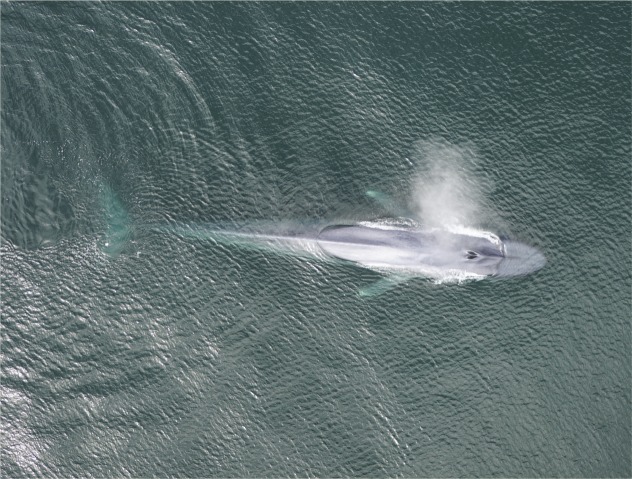Blue whale memory and migration
Blue whale (Balaenoptera musculus) migrates in the California current. Image courtesy of Jeremy A. Goldbogen (Stanford University, Stanford, CA) and the Duke Marine Robotics and Remote Sensing Lab.
Many migrant species track waves of high-quality food resources across landscapes. Although there is extensive research on terrestrial migration patterns, the migratory behaviors of marine animals have not been extensively explored. To determine what drives blue whale migration patterns, Briana Abrahms et al. (pp. 5582–5587) combined 10 years of data on daily blue whale movements collected from satellite tags with satellite-based phytoplankton measurements in the California Current Ecosystem. The timing of whale movements was compared to the timing of the spring phytoplankton bloom, which drives a coast-wide wave of krill, the whales’ primary prey. The authors report that the whales almost perfectly matched their migration to the historical average timing of the krill wave. Moreover, the whales preferentially foraged in areas with lower immediate food availability but higher and more predictable long-term productivity, compared with areas where they did not forage. The findings indicate that blue whales enhance their ability to track krill by remembering the locations of stable, high-quality foraging sites, but the whales’ reliance on memory could hamper adaptations to novel ecosystem conditions. — M.S.
Molecular correlates of preterm birth
Preterm infants, born before 37 weeks of gestation, have a higher mortality rate and are at risk of long-term medical complications. Approximately half of preterm births have no known fetal or maternal risk factors. Theo Knijnenburg, Joseph Vockley, Nyasha Chambwe, David Gibbs, et al. (pp. 5819–5827) employed an integrative systems biology approach to characterize the molecular effects of genetic and environmental factors on preterm birth. The authors analyzed whole genome sequences from 791 family trios of mother, father, and infant and combined the data with analysis of maternal RNA sequence expression, DNA methylation, and clinical factors and outcomes. Of these family trios, 270 represented preterm births, 44 of which were very early, arriving before 28 weeks. The analysis revealed 160 genes associated with preterm births, many of which were active in inflammatory pathways. Of these, 72 genes, some of which had been previously associated with preterm birth, appeared to be candidate biomarker genes for very early preterm birth. Notably, all three genetic datasets implicated the RAB31 and RBPJ genes, both members of the RAS oncogene family. The authors note that in addition to identifying candidate genes for preterm birth the integrative analysis approach can serve as a model for uncovering the basis of other multifactorial diseases. — T.H.D.
Thermal adaptation in leaf-dwelling organisms

The Indonesian weevil lives on leaf surfaces.
Thermal tolerance limits for ectotherms can vary between contrasting microhabitats and between species within the same microhabitat. To explain the latter observation, Sylvain Pincebourde and Jérôme Casas (pp. 5588–5596) examined the thermal tolerance limits of six herbivorous arthropods that live and feed on the leaves of the same host plant, as well as the effects of herbivory on leaf transpiration and temperature. Feeding by phloem-feeding arthropods, such as aphids, increased leaf transpiration and reduced leaf surface temperature, while feeding by tissue-piercing arthropods, such as mites and lace bugs, reduced transpiration and increased leaf surface temperature. Species’ upper thermal limits were correlated with the transpiration rate and temperature of the leaves they attacked, such that species whose feeding decreased transpiration and warmed the leaves could tolerate higher temperatures than species whose feeding increased transpiration and cooled the leaves. Thus, tissue piercers could tolerate higher temperatures than phloem feeders, but were also exposed to higher temperatures than phloem feeders. The difference between each species’ upper temperature limit and the warmest temperatures they currently experience was at most 2 °C for all species studied. The results suggest that the vulnerability of these species to extreme heat may be much smaller than previously thought, according to the authors. — B.D.
Climatic factors and decline of Cahokia
Multiple hypotheses have been proposed for the decline of Cahokia, a large prehistoric settlement that was located in Illinois, United States. Many hypotheses focus on possible social and environmental factors in the settlement’s depopulation. Difficulty in correlating environmental conditions and population sizes has reduced confidence in such hypotheses. A. J. White et al. (pp. 5461–5466) analyzed sediment cores from Horseshoe Lake, which is adjacent to the Cahokia settlement. The authors examined the cores’ paleoenvironmental data, including oxygen stable isotopes, as well as fecal stanols, chemical signatures of human settlement that can be used as a proxy for population size and are highly correlated in time with paleoenvironmental data. The authors report that around 1150 CE the climate at Horseshoe Lake shifted toward decreased summer precipitation and the Mississippi River flooded, placing stress on Cahokia’s agricultural system. Subsequent climatic changes and population decline suggest that the depopulation of Cahokia may have been influenced by the shift in climate accompanying the transition from the Medieval Climate Anomaly to the Little Ice Age. According to the authors, climatic factors should be considered alongside cultural and political factors in the decline of Cahokia. — P.G.
Nigerian infant mortality and oil spills
Nigeria, the most populous country in Africa, faces frequent oil spills, which can be hazardous to human health. However, how onshore spills affect infant and neonatal mortality remains poorly studied. Anna Bruederle and Roland Hodler (pp. 5467–5471) reviewed the dates and locations of 5,296 oil spills that occurred in the Niger Delta between January 2005 and July 2014 along with data from the 2013 Nigeria Demographic and Health Survey. The authors focused on infants of 2,744 surveyed Nigerian mothers who lived near an oil spill that occurred during the study period. The authors compared infant survival rates among siblings whose mothers became pregnant before and after nearby oil spills, and found that the neonatal mortality rate between 2006 and 2013 approximately doubled from 37.1 to 75.4 deaths per 1,000 live births when pregnant mothers lived less than 10 km away from a spill. Mortality decreased as the distance between spill sites and the mothers’ residence increased beyond 10 km. The findings suggest that preventing oil spills could save thousands of newborn children, according to the authors. — M.S.
Cognitive functioning and childhood affluence

Childhood affluence may affect cognitive functioning later in life. Image courtesy of Pixabay/QuinceMedia.
Previous studies have found correlations between advantageous childhood socioeconomic conditions (CSC) and high cognitive functioning in adulthood, but it is uncertain whether poor CSC can lead to cognitive decline. Marja Aartsen, Stéphane Cullati, Boris Cheval, Stefan Sieber, et al. (pp. 5478–5486) analyzed data from the Survey of Health, Aging, and Retirement that was collected between 2004 and 2015 from 24,066 individuals aged 50–96 years in Europe. To explore how CSC affects cognitive functioning, the authors examined how individuals’ CSC was associated with changes in verbal fluency and the ability to recall words over time. Although word recollection and verbal fluency over time was highest for individuals with the most advantageous CSC, these individuals also experienced a faster decline in verbal fluency than individuals with the least advantageous CSC. The findings suggest that cognitive aging is unavoidable and that neuronal loss cannot be repaired once underlying cognitive illnesses have become advanced. According to the authors, interventions to reduce cognitive decline late in life should consider past conditions, and preventative measures should begin in childhood. — M.S.



